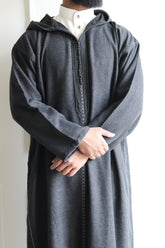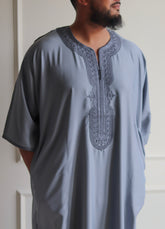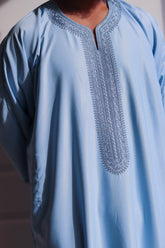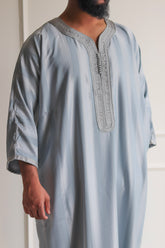Jub-bah
/dʒʊˈbə/;
Language: Arabic (جُبّة)
Translation: A long, loose-fitting robe, often worn in North Africa and the Middle East.
The Jubbah is far more than a garment—it's a story woven through centuries of tradition, practicality, and style. This iconic piece of Islamic clothing for men carries an air of timeless sophistication, while its roots stretch deep into the sands of ancient Arabia. But did you know the Jubbah has a surprising link to a modern wardrobe staple? Today, we dive into the rich legacy of the Jubbah, uncovering its meaning, evolution, and a linguistic twist you won’t see coming.
What Is a Jubbah?
The Jubbah is a long, flowing robe that exudes both elegance and utility. Typically made from breathable fabrics like cotton, wool, or linen, it was designed for comfort and adaptability in varying climates. Its ankle- or calf-length design, combined with its loose fit, made it perfect for movement—whether on horseback or simply navigating desert terrain.
Some Jubbahs are adorned with intricate embroidery, contrasting trims, or decorative accents around the neckline, cuffs, and hem. These embellishments often tell a story, reflecting cultural heritage or personal style. Whether simple or ornate, the Jubbah has always embodied grace and practicality.
A Garment of Timelessness
The origins of the Jubbah date back to ancient Arabia, where it was worn by desert nomads and city dwellers alike. For the nomads, it provided essential protection from the scorching sun and relentless sand. For others, it became a statement of social standing and spiritual devotion.
But the Jubbah's journey didn’t stop there. Over the centuries, it transcended its humble beginnings to become a garment that symbolizes dignity and identity, worn with pride across North Africa, the Middle East, and beyond.

From Jubbah to Jumper: A Linguistic Surprise
Here’s a fun fact: the modern word "jumper" owes its existence to the Jubbah! How, you ask? The term “jumper” stems from the Old French word jupe, which itself is derived from the Arabic jubbah. This fascinating linguistic evolution is a testament to how the Jubbah’s influence has quietly shaped global fashion over centuries.
Imagine that—a traditional robe from ancient Arabia leaving its mark on everyday clothing in the modern West! It’s a powerful reminder of how influencial the Islamic world once was.
Has Its Meaning Changed?
In essence, the Jubbah has stayed true to its roots as a long, loose-fitting garment. However, its role in society has evolved. While it remains a cornerstone of Islamic attire, it’s also embraced for its versatility and style.
Modern Jubbahs now come in a variety of fabrics and designs, appealing to contemporary tastes while preserving the essence of the original. Whether worn for religious gatherings, cultural celebrations, or as part of casual wear, the Jubbah effortlessly blends tradition with modernity.
The Jubbah Today: A Fashion Icon
Today, the Jubbah continues to make its mark. From mosques to weddings, it’s a staple in men’s wardrobes across the globe. But it doesn’t stop there—its timeless design has also caught the eye of fashion enthusiasts outside of its cultural origins.
The Jubbah’s clean lines and flowing silhouette offer a classic yet modern aesthetic that resonates with people seeking elegance and comfort. It’s a garment that transcends boundaries, proving that great style truly has no borders.
Conclusion
The Jubbah is more than just fabric—it’s a legacy. It’s a symbol of culture, resilience, and global influence, carrying stories of desert caravans, ancient civilizations, and evolving traditions.
So, the next time you see a Jubbah, take a moment to appreciate its rich history. And perhaps you’ll even smile at the thought that this age-old garment shares a surprising connection to the modern jumper hanging in your closet.
The Jubbah: timeless, versatile, and forever iconic.









